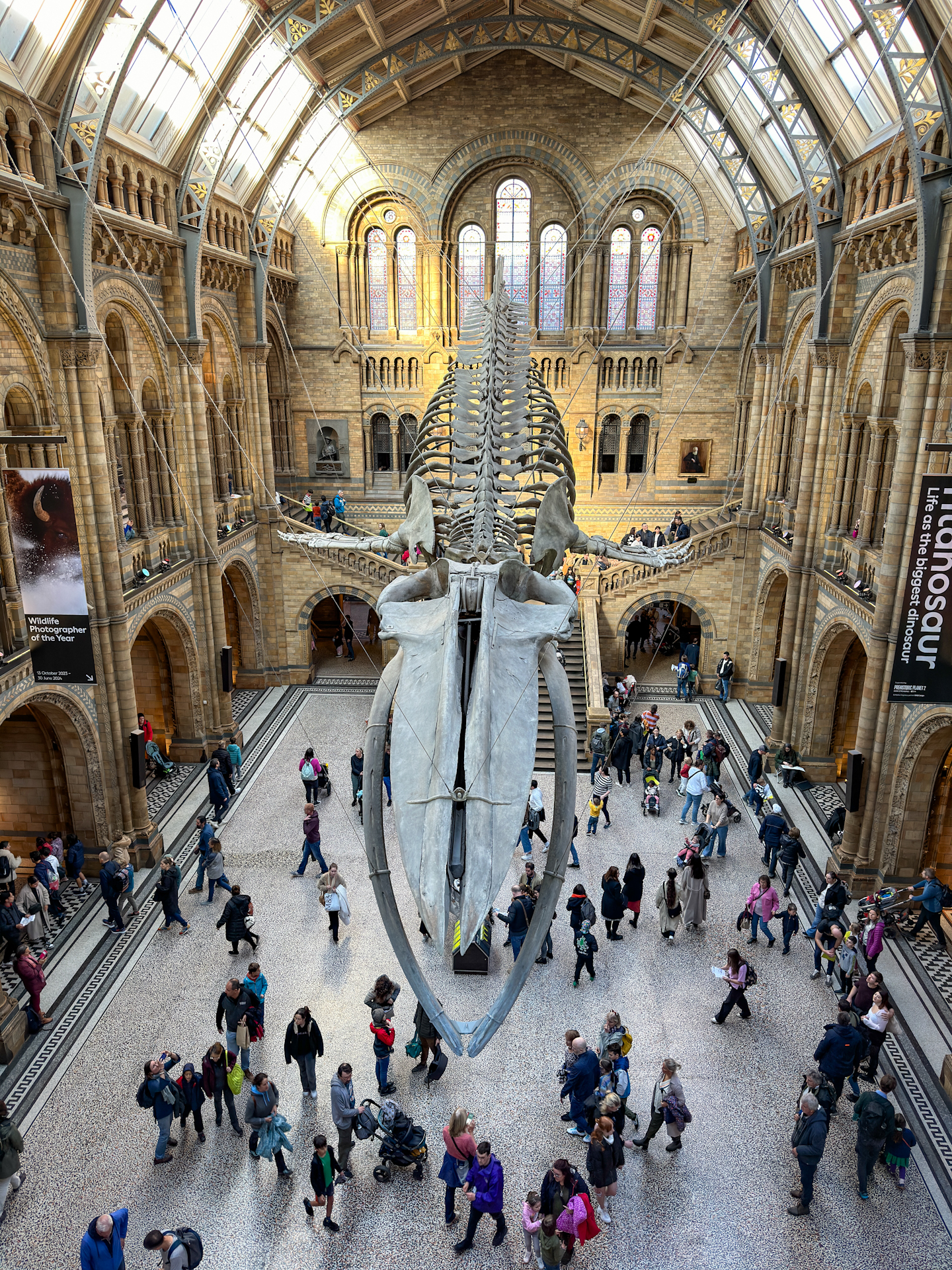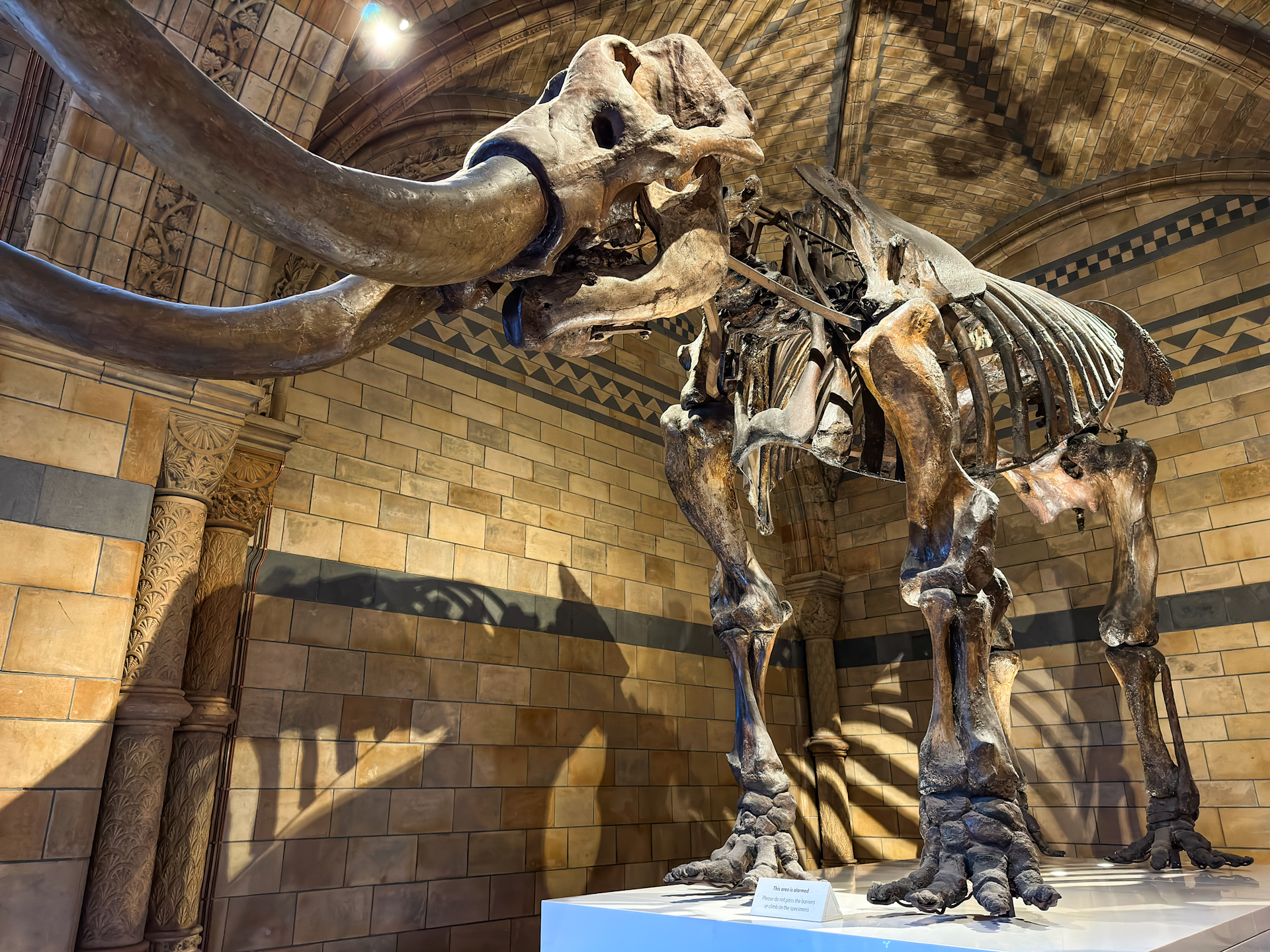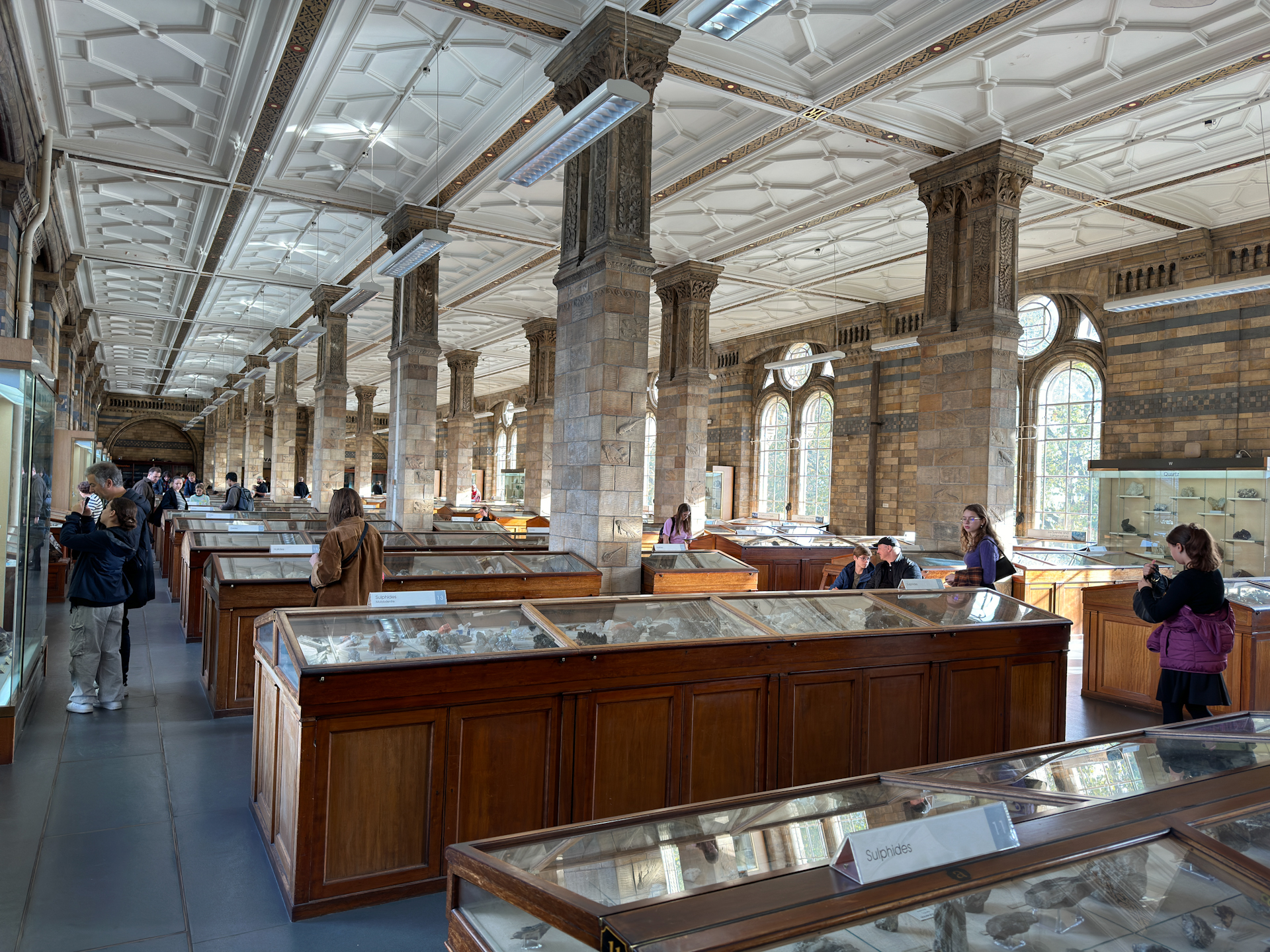The Natural History Museum is one of three large museums in South Kensington. Its speciality is life science and earth science. Like other publicly funded museums, the museum is free. It is also very popular, especially with families. A reservation lets you skip the long line at the door.
I would visit just to see Hintze Hall with its beautiful stone work, vaulted ceiling, M.C.Escher-like staircases, and the giant whale skeleton hanging in the middle like an alien about to have someone for lunch.


Once you have entered the Exhibition Road entrance and passed security you go up the Globe escalator. It appears to take you into a small globe hemmed in between two much larger globes. Note the children in the photo. There are many children at this museum.


Once you have entered the Exhibition Road entrance and passed security you go up the Globe escalator. It appears to take you into a small globe hemmed in between two much larger globes. Note the children in the photo. There are many children at this museum.


Once you have entered the Exhibition Road entrance and passed security you go up the Globe escalator. It appears to take you into a small globe hemmed in between two much larger globes. Note the children in the photo. There are many children at this museum.














Blue whale, or Balaenoptera musculus
Rescued from the brink of extinction in the 1960s, the blue whale is a symbol of hope for the future of the natural world. Hunted for their meat, oil and baleen, numbers fell from around 350,000 to as few as 400 in the late twentieth century. Since becoming a protected species, blue whale numbers have started to recover. Population estimates were up to 25,000 at the start of the twenty-first century. But threats such as marine pollution and climate change linger - the blue whale remains a vulnerable and endangered species.


Blue whale, or Balaenoptera musculus
Rescued from the brink of extinction in the 1960s, the blue whale is a symbol of hope for the future of the natural world. Hunted for their meat, oil and baleen, numbers fell from around 350,000 to as few as 400 in the late twentieth century. Since becoming a protected species, blue whale numbers have started to recover. Population estimates were up to 25,000 at the start of the twenty-first century. But threats such as marine pollution and climate change linger - the blue whale remains a vulnerable and endangered species.


Blue whale, or Balaenoptera musculus
Rescued from the brink of extinction in the 1960s, the blue whale is a symbol of hope for the future of the natural world. Hunted for their meat, oil and baleen, numbers fell from around 350,000 to as few as 400 in the late twentieth century. Since becoming a protected species, blue whale numbers have started to recover. Population estimates were up to 25,000 at the start of the twenty-first century. But threats such as marine pollution and climate change linger - the blue whale remains a vulnerable and endangered species.








Giraffes are the tallest living animals on Earth. Their long necks illustrate the power of evolution by natural selection.
Giraffes belong to a large group of mammal species that are adapted to graze on different types of plants. Their necks allow them to feed on tall bushes and shrubs beyond the reach of other species. Grazing by mammals plays a key role in the maintenance of African savannah ecosystems.
Remarkably, a giraffe's neck contains the same number of bones as a human's. Gradual natural selection over many generations has led to the bones becoming much longer.
The Natural History Museum's mammal collection is an important reference for the classification of species. It is used to describe new species and identify populations in need of conservation.


Giraffes are the tallest living animals on Earth. Their long necks illustrate the power of evolution by natural selection.
Giraffes belong to a large group of mammal species that are adapted to graze on different types of plants. Their necks allow them to feed on tall bushes and shrubs beyond the reach of other species. Grazing by mammals plays a key role in the maintenance of African savannah ecosystems.
Remarkably, a giraffe's neck contains the same number of bones as a human's. Gradual natural selection over many generations has led to the bones becoming much longer.
The Natural History Museum's mammal collection is an important reference for the classification of species. It is used to describe new species and identify populations in need of conservation.


Giraffes are the tallest living animals on Earth. Their long necks illustrate the power of evolution by natural selection.
Giraffes belong to a large group of mammal species that are adapted to graze on different types of plants. Their necks allow them to feed on tall bushes and shrubs beyond the reach of other species. Grazing by mammals plays a key role in the maintenance of African savannah ecosystems.
Remarkably, a giraffe's neck contains the same number of bones as a human's. Gradual natural selection over many generations has led to the bones becoming much longer.
The Natural History Museum's mammal collection is an important reference for the classification of species. It is used to describe new species and identify populations in need of conservation.


Insects make up more than half of all known species. They are vital to life on our planet.
With nearly a million named species and many more awaiting discovery, insects are the largest and most diverse group of living animals.
This specimen tray illustrates each of the orders, or groups, of living insects and their close relatives. The swarms highlight the six most diverse groups: beetles; flies; butterflies and moths; wasps, bees and ants; crickets and grasshoppers; and dragonflies.
The Natural History Museum houses more than 37 million insect specimens, representing more than half the known species. Scientists study the collections to better understand the close relationships insects have evolved with plants and other animals, particularly their role as key pollinators, pests and vectors of disease.


Insects make up more than half of all known species. They are vital to life on our planet.
With nearly a million named species and many more awaiting discovery, insects are the largest and most diverse group of living animals.
This specimen tray illustrates each of the orders, or groups, of living insects and their close relatives. The swarms highlight the six most diverse groups: beetles; flies; butterflies and moths; wasps, bees and ants; crickets and grasshoppers; and dragonflies.
The Natural History Museum houses more than 37 million insect specimens, representing more than half the known species. Scientists study the collections to better understand the close relationships insects have evolved with plants and other animals, particularly their role as key pollinators, pests and vectors of disease.


Insects make up more than half of all known species. They are vital to life on our planet.
With nearly a million named species and many more awaiting discovery, insects are the largest and most diverse group of living animals.
This specimen tray illustrates each of the orders, or groups, of living insects and their close relatives. The swarms highlight the six most diverse groups: beetles; flies; butterflies and moths; wasps, bees and ants; crickets and grasshoppers; and dragonflies.
The Natural History Museum houses more than 37 million insect specimens, representing more than half the known species. Scientists study the collections to better understand the close relationships insects have evolved with plants and other animals, particularly their role as key pollinators, pests and vectors of disease.




















This ice-age relative of the elephant roamed North America until 30-40,000 years ago.
These magnificent beasts co-existed with humans until they were eventually driven to extinction by a combination of hunting, habitat loss, and climate change.
Acquired by the museum in 1844, Sir Richard Owen, our first Director, repositioned the mastodon into its current, accurate position revealing its relationship to living elephants. The Natural History Museum's palaeontology collection includes more than 250,000 fossile mammals, covering over 200 million years of mammalian evolutionary history.


This ice-age relative of the elephant roamed North America until 30-40,000 years ago.
These magnificent beasts co-existed with humans until they were eventually driven to extinction by a combination of hunting, habitat loss, and climate change.
Acquired by the museum in 1844, Sir Richard Owen, our first Director, repositioned the mastodon into its current, accurate position revealing its relationship to living elephants. The Natural History Museum's palaeontology collection includes more than 250,000 fossile mammals, covering over 200 million years of mammalian evolutionary history.


This ice-age relative of the elephant roamed North America until 30-40,000 years ago.
These magnificent beasts co-existed with humans until they were eventually driven to extinction by a combination of hunting, habitat loss, and climate change.
Acquired by the museum in 1844, Sir Richard Owen, our first Director, repositioned the mastodon into its current, accurate position revealing its relationship to living elephants. The Natural History Museum's palaeontology collection includes more than 250,000 fossile mammals, covering over 200 million years of mammalian evolutionary history.








Seaweeds harness energy for marine life. They are essential to the survival of ocean ecosystems. These are red, green and brown species of seaweed, found in Pembrokeshire and Devon, UK
Seaweeds illustrate the astounding complexity of the Tree of Life. Red and green species of seaweed are close relatives of land plants, while brown species are evolutionarily very different.
These species show that outward appearance is not always a reliable indicator of evolutionary relationships. Seaweeds have long been a source of food for humans and livestock, and are increasingly being explored as a potential source of biofuels, medicines and fertilisers.
The Museum's botany collection contains more than six million specimens of algae, plants and fungi. The collection is used to inform the conservation of endangered habitats and the identification of new crops and chemicals.


Seaweeds harness energy for marine life. They are essential to the survival of ocean ecosystems. These are red, green and brown species of seaweed, found in Pembrokeshire and Devon, UK
Seaweeds illustrate the astounding complexity of the Tree of Life. Red and green species of seaweed are close relatives of land plants, while brown species are evolutionarily very different.
These species show that outward appearance is not always a reliable indicator of evolutionary relationships. Seaweeds have long been a source of food for humans and livestock, and are increasingly being explored as a potential source of biofuels, medicines and fertilisers.
The Museum's botany collection contains more than six million specimens of algae, plants and fungi. The collection is used to inform the conservation of endangered habitats and the identification of new crops and chemicals.


Seaweeds harness energy for marine life. They are essential to the survival of ocean ecosystems. These are red, green and brown species of seaweed, found in Pembrokeshire and Devon, UK
Seaweeds illustrate the astounding complexity of the Tree of Life. Red and green species of seaweed are close relatives of land plants, while brown species are evolutionarily very different.
These species show that outward appearance is not always a reliable indicator of evolutionary relationships. Seaweeds have long been a source of food for humans and livestock, and are increasingly being explored as a potential source of biofuels, medicines and fertilisers.
The Museum's botany collection contains more than six million specimens of algae, plants and fungi. The collection is used to inform the conservation of endangered habitats and the identification of new crops and chemicals.